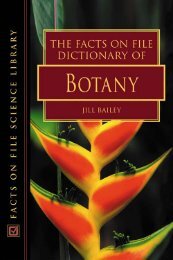You also want an ePaper? Increase the reach of your titles
YUMPU automatically turns print PDFs into web optimized ePapers that Google loves.
CHAPTER 8<br />
Sexual reproduction<br />
Introduction<br />
The great majority of ferns arc homosporous, with<br />
numerous haploid spores being produced by<br />
meiosis in the sporangia borne on the leaves of rhe<br />
diploid plant (sporophyte, 1.7). When the spores<br />
are shed rhey develop into small, but free-living,<br />
green gametophytes (8.1) on which the gametes<br />
3rc later formed. Fusion of the motile sperm with<br />
the egg results in a diploid embryo; this reestablishes<br />
the sporophyte generation which is<br />
soon independent of the gamctophyrc.<br />
The seed plants are heterosporous and do not<br />
show a free-living gamctophyce generation. In the<br />
gymnosperms a single haploid megaspore matures<br />
to form the embryo sac within the naked female<br />
ovule (1.5, 1.32). This megaspore is formed by the<br />
meiosis of a solitary meg:lspore mother cell<br />
located in the diploid nucellus (megasporangium).<br />
Only one of the four resulram spores matures<br />
while the others abort (1.32). Both the embryo sac<br />
and nuceUus are enclosed within an inregumenr<br />
and these strucrures collectively constitute the<br />
ovule (1.32) which is retained on the tree (1.5).<br />
The haploid megaspore divides repeatedly to form<br />
a mass of gametoph}'tic tissue within the<br />
enlargened embryo sac, and eventually one or<br />
more eggs become demarcated within this tissue<br />
close to the micropyle (8.2).<br />
Following pollination of the ovule by a microspore,<br />
the egg is fertilised by a sperm and the diploid<br />
embryo develops. The testa of the marure<br />
seed is formed from the modified integument of<br />
the ovule, while copious food reserves for the<br />
future seedling are contained within the tissue of<br />
the female gametophyte surrounding the embryo<br />
(1.32,8.2).<br />
In flowering plants the ovule is enclosed within<br />
an ovary (1.32) in contrast to the exposed ovule in<br />
gymnosperms (1.5). The female gamerophyte<br />
within the embryo sac is typically reduced to eight<br />
cells and one of these, at the micropylar end of the<br />
embryo sac. represents the egg (1.32). In contrast<br />
to gymnosperms double fertilisation occurs in<br />
angiosperms with one sperm fertilising the egg to<br />
form the diploid embryo (1.33) while the other<br />
sperm fertilises the twO central polar nuclei to<br />
form the triploid, nutritive endosperm (1.32)<br />
which is initially coenocytjc.<br />
General features of flowers<br />
Most flowers contain both male and female sex<br />
organs (1.1,1.31) but some flowers are unisexual<br />
(8.3) and may occur on the same plant (8.3) or<br />
separale individuals. The flower of Magnolia<br />
(1.31) illustrates the general features of a<br />
dicolyledon. The upper half of the elongate<br />
receptacle (floral axis) is covered by a large<br />
number of spirally arranged and separate female<br />
organs (carpels) which collectively constirute rhe<br />
apocarpous gynoecium. Below the carpels numerous<br />
spirally arranged male organs (stamens<br />
constituting the androecium) are inserted ontO rhe<br />
receptacle by shorr filaments. These are rerminalcd<br />
by large anthcrs containing the pollen (microspores).<br />
Ar the base of the receptacle there are<br />
usually nine large, petaloid, periamh members.<br />
In contrast with Magnolia, the monocotyledonous<br />
flower of Lilillm (1.1) has six petaloid<br />
periamh members arranged in two alternating<br />
whorls. These encircle six stamens, while the<br />
syncarpous gynoecium consists of three fused<br />
carpels. The three comparnnents of the ovary arc<br />
clearly visible on the fcuits developing after the<br />
flowers wither (1.1). The ovary in Li/ium is<br />
terminated by a long. slender style which is tipped<br />
by a slightly swollen stigma. As in Magnolia the<br />
ovary is superior since its poinr of insertion lies<br />
above Ihe rest of the floral parts, but in orher<br />
flowers the ovary may be inferior (8.4). In the<br />
early dcvclopmcnl of most flowers the organ<br />
primordia arise in centripetal sequence so that the<br />
petiamh is iniri





